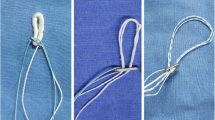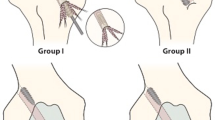Abstract
For currently presented anatomical coracoclavicular ligament repairs issues such as autologous tendon graft versus synthetic suture augmentation and the optimum fixation strategies for both types of reconstruction are not solved. The purpose of the study was to compare the biomechanical properties of different tendon graft repairs to the characteristics of a synthetic polyester augmentation. Four anatomical coracoclavicular ligament repairs were biomechanically tested: 5 mm coracoclavicular tendon loop with suture fixation, tendon loop with flip button fixation, tendon loop with interference screw fixation versus a double 1.0-mm polyester repair with flip button fixation. The biomechanical testing included cyclic superio-inferior loading and a subsequent load to failure protocol. The ultimate failure loads were significantly higher for the double polyester/flip button repair (927 N) compared to all tendon repair techniques (maximum 640 N). In contrast the stiffness level was higher for the tendon repairs compared to the polyester/flip button repair (68.7 N/mm) but strongly dependent on the fixation technique (interference screw 97.2 N/mm, flip button 84.9 N/mm, side to side suture 60.9 N/mm). A synthetic coracoclavicular augmentation using a polyester suture provides adequate structural properties compared to a tendon repair. Therefore the decision for a tendon graft should be made by the necessity of a biologic substrate rather than by the assumption of a biomechanical advantage.


Similar content being viewed by others
References
Bannister GC, Wallace WA, Stableforth PG, Hutson MA (1989) The management of acute acromioclavicular dislocation. A randomised prospective controlled trial. J Bone Joint Surg Br 71:848–850
Barber FA, Herbert MA, Richards DP (2003) Sutures and suture anchors: update 2003. Arthroscopy 19:985–990
Costic RS, Jari R, Rodosky MW, Debski RE (2003) Joint compression alters the kinematics and loading patterns of the intact and capsule-transected AC joint. J Orthop Res 21:379–385
Costic RS, Labriola JE, Rodosky MW, Debski RE (2004) Biomechanical rationale for development of anatomical reconstructions of coracoclavicular ligaments after complete acromioclavicular joint dislocations. Am J Sports Med 32:1929–1936
Costic RS, Vangura A Jr, Fenwick JA, Rodosky MW, Debski RE (2003) Viscoelastic behavior and structural properties of the coracoclavicular ligaments. Scand J Med Sci Sports 13:305–310
Debski RE, Parsons IM III, Fenwick J, Vangura A (2000) Ligament mechanics during three degree-of-freedom motion at the acromioclavicular joint. Ann Biomed Eng 28:612–618
Debski RE, Parsons IM, Woo SL, Fu FH (2001) Effect of capsular injury on acromioclavicular joint mechanics. J Bone Joint Surg Am 83-A:1344–1351
Duprey S, Bruyere K, Verriest JP (2008) Influence of geometrical personalization on the simulation of clavicle fractures. J Biomech 41:200–207
Erak S, Pelletier MH, Woods KR, Smith PN, Walsh WR (2008) Acromioclavicular reconstructions with hamstring tendon grafts: a comparative biomechanical study. J Shoulder Elbow Surg 17:772–778
Fukuda K, Craig EV, An KN, Cofield RH, Chao EY (1986) Biomechanical study of the ligamentous system of the acromioclavicular joint. J Bone Joint Surg Am 68:434–440
Grutter PW, Petersen SA (2005) Anatomical acromioclavicular ligament reconstruction: a biomechanical comparison of reconstructive techniques of the acromioclavicular joint. Am J Sports Med 33:1723–1728
Harris RI, Vu DH, Sonnabend DH, Goldberg JA, Walsh WR (2001) Anatomic variance of the coracoclavicular ligaments. J Shoulder Elbow Surg 10:585–588
Harris RI, Wallace AL, Harper GD, Goldberg JA, Sonnabend DH, Walsh WR (2000) Structural properties of the intact and the reconstructed coracoclavicular ligament complex. Am J Sports Med 28:103–108
Hernegger GS, Kadletz R (2006) Tight Rope-The revolutionary anatomical fixation in acromioclavicular joint dislocation-A case report. Tech Shoulder Elbow Surg 7:86–88
Jari R, Costic RS, Rodosky MW, Debski RE (2004) Biomechanical function of surgical procedures for acromioclavicular joint dislocations. Arthroscopy 20:237–245
Klimkiewicz JJ, Williams GR, Sher JS, Karduna A, Des JJ, Iannotti JP (1999) The acromioclavicular capsule as a restraint to posterior translation of the clavicle: a biomechanical analysis. J Shoulder Elbow Surg 8:119–124
Krackow KA, Cohn BT (1987) A new technique for passing tendon through bone. Brief note. J Bone Joint Surg Am 69:922–924
LaPrade RF, Hilger B (2005) Coracoclavicular ligament reconstruction using a semitendinosus graft for failed acromioclavicular separation surgery. Arthroscopy 21:1277
Larsen E, Bjerg-Nielsen A, Christensen P (1986) Conservative or surgical treatment of acromioclavicular dislocation. A prospective, controlled, randomized study. J Bone Joint Surg Am 68:552–555
Lee KW, Debski RE, Chen CH, Woo SL, Fu FH (1997) Functional evaluation of the ligaments at the acromioclavicular joint during anteroposterior and superoinferior translation. Am J Sports Med 25:858–862
Lee SJ, Keefer EP, McHugh MP, Kremenic IJ, Orishimo M, Ben Avi S, Nicholas SJ (2008) Cyclic loading of coracoclavicular ligament reconstructions. Am J Sports Med 36:1990–1996
Lee SJ, Nicholas SJ, Akizuki KH, McHugh MP, Kremenic IJ, Ben Avi S (2003) Reconstruction of the coracoclavicular ligaments with tendon grafts: a comparative biomechanical study. Am J Sports Med 31:648–655
Lorbach O, Bachelier F, Vees J, Kohn D, Pape D (2008) Cyclic loading of rotator cuff reconstructions: single-row repair with modified suture configurations versus double-row repair. Am J Sports Med 36:1504–1510
Mazzocca AD, Santangelo SA, Johnson ST, Rios CG, Dumonski ML, Arciero RA (2006) A biomechanical evaluation of an anatomical coracoclavicular ligament reconstruction. Am J Sports Med 34:236–246
Motamedi AR, Blevins FT, Willis MC, McNally TP, Shahinpoor M (2000) Biomechanics of the coracoclavicular ligament complex and augmentations used in its repair and reconstruction. Am J Sports Med 28:380–384
Rios CG, Arciero RA, Mazzocca AD (2007) Anatomy of the clavicle and coracoid process for reconstruction of the coracoclavicular ligaments. Am J Sports Med 35:811–817
Rockwood C (1984) Injuries in the acromioclavicular joint: subluxations and dislocations about the shoulder. In: Rockwood CA Jr, Green D (eds) Fracture in adults. JB Lippincott, Philadelphia, pp 860–910
Rupp S, Georg T, Gauss C, Kohn D, Seil R (2002) Fatigue testing of suture anchors. Am J Sports Med 30:239–247
Salzmann GM, Paul J, Sandmann GH, Imhoff AB, Schottle PB (2008) The coracoidal insertion of the coracoclavicular ligaments: an anatomic study. Am J Sports Med 36:2392–2397
Seil R, Rupp S, Krauss PW, Benz A, Kohn DM (1998) Comparison of initial fixation strength between biodegradable and metallic interference screws and a press-fit fixation technique in a porcine model. Am J Sports Med 26:815–819
Spang JT, Weinhold PS, Karas SG (2006) A biomechanical comparison of EndoButton versus suture anchor repair of distal biceps tendon injuries. J Shoulder Elbow Surg 15:509–514
Tossy JD, Mead NC, Sigmond HM (1963) Acromioclavicular separations: useful and practical classification for treatment. Clin Orthop Relat Res 28:111–119
Walz L, Salzmann GM, Fabbro T, Eichhorn S, Imhoff AB (2008) The anatomic reconstruction of acromioclavicular joint dislocations using 2 TightRope devices: a biomechanical study. Am J Sports Med 36:2398–2406
Wellmann M, Zantop T, Petersen W (2007) Minimally invasive coracoclavicular ligament augmentation with a flip button/polydioxanone repair for treatment of total acromioclavicular joint dislocation. Arthroscopy 23:1132–1135
Wellmann M, Zantop T, Weimann A, Raschke MJ, Petersen W (2007) Biomechanical evaluation of minimally invasive repairs for complete acromioclavicular joint dislocation. Am J Sports Med 35:955–961
Author information
Authors and Affiliations
Corresponding author
Rights and permissions
About this article
Cite this article
Wellmann, M., Kempka, J.P., Schanz, S. et al. Coracoclavicular ligament reconstruction: biomechanical comparison of tendon graft repairs to a synthetic double bundle augmentation. Knee Surg Sports Traumatol Arthrosc 17, 521–528 (2009). https://doi.org/10.1007/s00167-009-0737-9
Received:
Accepted:
Published:
Issue Date:
DOI: https://doi.org/10.1007/s00167-009-0737-9




